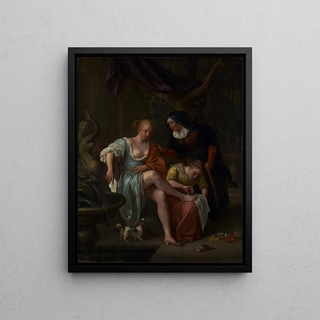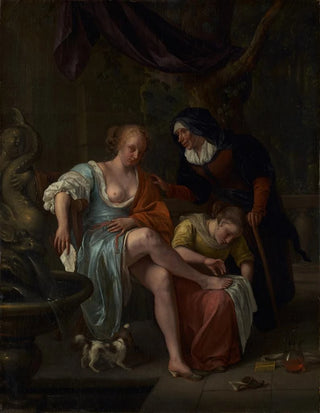Art print | Bathsheba after her bath - Jan Steen


View from behind

Frame (optional)
The artwork "Bethsabée after the bath" by Jan Steen is a true ode to the beauty and complexity of human emotions. Painted in the 17th century, this canvas depicts a pivotal moment in biblical history, where Bethsabée, Urie's wife, finds herself in a delicate situation. The scene not only portrays the sensuality of the woman but also explores the moral and social ramifications of her actions. Jan Steen, master of Dutch painting, manages to capture the very essence of everyday life while infusing it with narrative depth. The piece invites viewers to contemplate the duality of beauty and guilt, a theme that resonates across ages.
Style and uniqueness of the work
Jan Steen's style is characterized by vibrant colors and meticulous attention to detail. In "Bethsabée after the bath," warm, golden hues create an intimate atmosphere, while light plays a crucial role, illuminating the woman's body and emphasizing her curves. The composition is dynamic, with elements that seem to interact with each other, evoking an almost cinematic storytelling. Steen excels in staging, with each character and object telling its own story. The juxtaposition between Bethsabée's beauty and the shadow of her choices' consequences creates palpable tension, inviting viewers to focus on the details while reflecting on the moral implications of the scene.
The artist and his influence
Jan Steen, born in Leiden in 1626, is often regarded as one of the greatest painters of his time. His work reflects a Dutch society in full effervescence, where domestic life and social morals are scrutinized with a critical and humorous eye. Steen does not merely depict genre scenes; he infuses them with psychological depth that transcends simple entertainment. His influence is evident in many artists who followed him, seeking to capture the complexity of human experience through rich, narrative compositions. The way he addresses universal themes such as love, morality, and desire continues to inspire contemporary artists.

Matte finish

View from behind

Frame (optional)
The artwork "Bethsabée after the bath" by Jan Steen is a true ode to the beauty and complexity of human emotions. Painted in the 17th century, this canvas depicts a pivotal moment in biblical history, where Bethsabée, Urie's wife, finds herself in a delicate situation. The scene not only portrays the sensuality of the woman but also explores the moral and social ramifications of her actions. Jan Steen, master of Dutch painting, manages to capture the very essence of everyday life while infusing it with narrative depth. The piece invites viewers to contemplate the duality of beauty and guilt, a theme that resonates across ages.
Style and uniqueness of the work
Jan Steen's style is characterized by vibrant colors and meticulous attention to detail. In "Bethsabée after the bath," warm, golden hues create an intimate atmosphere, while light plays a crucial role, illuminating the woman's body and emphasizing her curves. The composition is dynamic, with elements that seem to interact with each other, evoking an almost cinematic storytelling. Steen excels in staging, with each character and object telling its own story. The juxtaposition between Bethsabée's beauty and the shadow of her choices' consequences creates palpable tension, inviting viewers to focus on the details while reflecting on the moral implications of the scene.
The artist and his influence
Jan Steen, born in Leiden in 1626, is often regarded as one of the greatest painters of his time. His work reflects a Dutch society in full effervescence, where domestic life and social morals are scrutinized with a critical and humorous eye. Steen does not merely depict genre scenes; he infuses them with psychological depth that transcends simple entertainment. His influence is evident in many artists who followed him, seeking to capture the complexity of human experience through rich, narrative compositions. The way he addresses universal themes such as love, morality, and desire continues to inspire contemporary artists.






